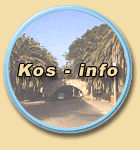|

|
THE ASKLEPIEION OF KOS.
From the "Special Edition" of "The Asklepieion of Kos" - By Vassilis S. Hatzivassiliou KOS 2000.
The Re-enactment of the
Oath of Hippocrates is performed occasionally in the second terrace of Asklepieion.
Information map of the Asklepieion.
General view of the 1st terrace.
Back to the Top of the page!
Take me back!
|

![]()
![]()
![]()
![]()
![]()
![]()
![]()
![]()
![]()
![]()
![]()
![]()
![]()
![]()